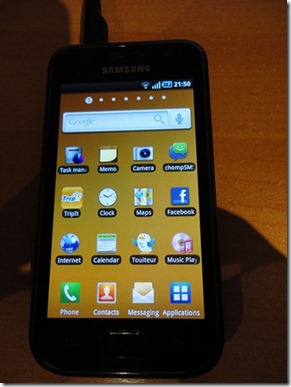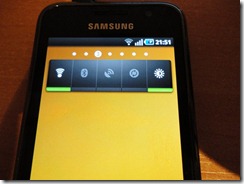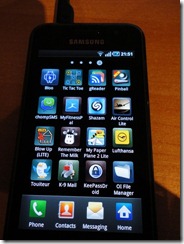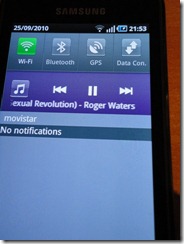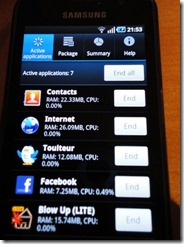[UPDATE NOTE: Although much of this post is accurate and my overall impressions are in the Summary, you might be interested in knowing that after 8 months, I ended up selling this device and purchasing an iPhone 4. Why? Some day I’ll blog about it….]
After being an iPhone user for over two years, the day before iOS 4.1 was released, I purchased a Samsung Galaxy S. Like many iPhone users I made the terrible mistake of upgrading my iPhone 3G to iOS 4. And like many, I suffered the consequences. Being left-handed and not a big iTunes devote, getting the iPhone 4 was not that attractive of an option and I was quite interested in trying out Android. So I decided to settle on the Galaxy S.
The Hardware
I was quite surprised when I picked up the phone as it was extremely light, even with the battery. Width-wise it’s pretty much the same as the iPhone 3G. In height it’s around 1cm longer. Having the feeling of being able to take off the cover and get access to the battery was kind of overwhelming. For over two years I had forgotten what a phone battery even looked like. The case feels less solid than the iPhone however. So far I’ve not dropped it, and I’d be concerned to do so since it feels like it wouldn’t survive a fall (my iPhone twice rolled down several stone stairs and survived, among other accidents).
Contrary to the iPhone and many other phones, the Power socket and USB connection is on the top part of the phone, next to the ear jack. Similar to the iPhone it has 3 hardware buttons, the middle Home one, then volume control on the left and a power button on the right. This last one can be used to not only power the phone off, but also select a variety of options such as putting the phone in Silent Mode, Connectivity options as well as Flight Mode. It also comes with two touch (?) buttons on each side of the Home button. The left one is used to get access to contextual options for each application, and the right one is a general “back button”.
The screen size is larger than the iPhone and although not by much, it really does make a difference when using the browser and other applications. Much nicer. Also, the fact that the menu options and back button are not “on the screen” per se, it allows for more surface area for applications (i.e. no row with a “Back” or “Edit” or “Done” on the top part of every screen).
In regards to storage, by default, mine comes with an internal 8GB storage, however you can extend it using an SD card which is quite nice.
Camera and Video
The phone comes with a 5MP camera and can also record VGA video. The quality is not bad at all. Much better than the iPhone (probably not as good as the iPhone 4 however from some comparison I saw recently). Then again, for my usage of the camera, it’s more than sufficient. It also has a mode to capture text (thanks Gary) which is great for snapshots of business cards, etc.
Home Screen
Android operating system (to the best of my knowledge this is Android generic and not Samsung specific) has what we could consider a Desktop and also an Applications Folder. The Desktop is what you see when you access the phone. It’s where you can place your frequently used applications. You have 7 desktop (Image 1), that is you can scroll left and right between them.
On one of the desktops you have quick access to activate and deactivate certain functionality such as Bluetooth, WiFi, etc
On the first desktop you have a similar row of applications like that of iOS4 that remain static across all desktops. However, contrary to the iOS4, I’ve not been able to change these items. Maybe there’s a way. Icons don’t snap into position like they do with the iOS4, so you can place them anywhere. The normal procedure is to access the application folder and drag them over to the desktop. You access the Application folder by clicking on the Applications icon (see first image, bottom right)
The desktop background is also configurable with either static pictures, from photo album or a live gallery with moving images. The overall experience of the desktop is not much different from iOS4. One advantage is that you don’t clutter your screens with applications you don’t want quick access to (of course iOS4 did introduce folders).
Purchasing Applications and Installations
With iOS4, purchasing is quite simple. iTunes requires that you register your credit card details so that it’s really a one click operation to purchase. This is both a good thing and a bad one, specially if your kids know your password. With the Android, although I’ve not yet purchased an application, I did see it requires you to fill out payment details each time, which can also become quite cumbersome. Then again, maybe you can save this. Not sure.
The installation process is nicer too. With iOS4, every time you purchase an application, it takes you back to your “desktop” and shows its progress. With Android, it performs the download it background and allows you to continue to look through the store.
Favorite Apps
The variety of applications is quite good. I’ve not yet missed any app that I’ve had on the iPhone. Quite the contrary, I’ve found some things (KeePass anyone) that I’d not had on iOS due to Apple’s silly policies. The default Mail application does suck quite a bit, but then again I wasn’t a big fan of the iOS one either. Since I use Gmail, I just stick to the Browser version. For Twitter, not having Tweetdeck, I’m using Touiteur which isn’t bad. For SMS I use ChompSMS which gives more iOS feeling to it.
I have found quite a few Games on the Android that were also available on the iPhone and I have to say that the quality of the graphics were far superior on the iPhone. Now whether this is a limitation of the platform or it’s developer competence, I’m not sure.
Music
Listening to Music is pretty similar in experience to iPhone. You have access to artists, albums, playlists, etc. The default application does not know what a Podcast is, but then again, it doesn’t matter much. There’s also some specific Podcast apps I’m sure if you really need it.
The headphones I’m not too fond of. They have some plastic around them that form a kind of suction effect in your ears. Sure it might provide a better sound experience, but it also is quite an annoying feeling.
Making Calls
Phone experience is similar to the iPhone except some operations require two key presses. For instance, with the iPhone when you click on a Favorite contact, it automatically dials. Here it displays the contact’s details and you then have to choose a phone. Of course, the advantage is that can also choose to send a text message, email and ot her operations from the same place, so it is quite useful.
Update: Apparently, instead of pressing the contact, if you slide your finger, it will dial the first number. Thanks to Leonxki for the tip
Notification Area
The top bar of the phone displays all the notifications you receive. These can be from missed calls, SMS’s, Emails, Facebook notifications, etc. I have to say, I love it. One thing I didn’t like about the iPhone is that you had to look at the application icons to see notifications. Here they are all available on one screen that you literally just pull down (using fingers to scroll top bar down). You can then access the application directly from there. The other great thing is that they remain there until you clear them. This works great for things like appointment notifications. With the iPhone, once you read an appointment it was gone. Here you can snooze it!
(notice that if you have Music playing you can access the app and controls from the notification area also. Very handy)
Connectivity
No issues in terms of connectivity. Phone network has been the same as iPhone, both at home and during roaming. WiFi is simple to configure much like the iPhone and Bluetooth works great. In fact, I get a much better experience when hooking it up to the car system. I’ve had data connections over GPRS as well as 3G without any issues. However, GPS is a different matter.
Despite coming with a couple of Navigation applications, the GPS leaves quite a bit to be desired. I once used it to find my way and it was lagging behind about 1km and would frequently lose the GPS signal. Apparently there are some issues in regard to this.
When it comes to Tethering, although Kies offers the option I’ve not been able to get it to work, partly cause I have problems connecting the device*. However, you can also use Tethering easily using what’s called the MobileAP option on the phone. It sets up the phone as a gateway and you connect to it using WiFi and a key. Problem is that it only uses 3G so I can’t tether using Telefonica’s WiFi zones for instance. I’ve yet to play with this more though.
- Considering I managed to even upgrade the firmware on the first connect, I find it strange Kies just stopped working.
Syncing
To sync with the phone you normally use Kies (i.e. Samsung’s version of iTunes). It’s not the nicest user experience and I only managed to get it to work once, and once again, there seem to be some issues with the software and Windows 7 64bit. However, you can configure the phone to connect as a USB device which pretty much means that you can access any folder and transfer things manually, from music to videos to photos.
Regarding Mail, Calendar and Contacts, it’s Google. If you use Gmail and have your contacts in Gmail, then you’re pretty much set. It syncs over the cloud and does a great job at it. The Calendar is actually nicer than the iPhone one. Before on the iPhone I used to use the browser based calendar since it provided better information when you have more than one Gmail calendar. On the Android, the calendar provides native integration with Google so it works out great.
Input
The onscreen keyboard input is great. Better distance between keys makes it easier to type on. I was a little surprised as to not having spell correctors until someone pointed me to Swype. This is an input method that allows you to swipe your fingers through the letters of the word you want to type and it will automatically insert it for you. If it has doubts, it will prompt you with options. It works amazingly well and I’ve switched to this ever since.
Battery
If there’s one thing that I don’t like, it’s the batter life. I’ve not yet managed to get more than a day of usage out of it without having to recharge it. Depending on what you’re doing, it can also drain the battery quite fast. I’ve noticed 3G and WiFi contribute substantially whereas for instance Bluetooth or listening to music or playing games do not much.
The difference also with the iPhone is that it allows you to run more than one application at a time (remember the Windows Mobile days?). This means that when you launch an application, it sits running in background. Some say this contributes to battery usage although others disagree. The phone actually provides statistics on how much each application or activity has an impact on battery life and most of these applications don’t seem to contribute much since they pretty much sit in the background with 0% CPU usage. You can however kill applications if you like easily using the Task Manager.
Openness
One great thing about the phone is that it’s open. Not only can you configure pretty much anything you want, but you can also access the file system easily. When it comes to installed applications, you have the same benefits. Don’t like the SMS app? No problem. You can change it and make it the default app on the system. Don’t like the default Music application? Again, just change it. You’re pretty much open to do anything you want.
Overall impressions
At first when I started using the new phone, I felt like a Windows users thrown in front of Ubuntu (not Linux). It kind of felt odd to find my way around. Although many things were similar to iOS, I had gotten used to a certain way of working and it was strange to have to adapt in some cases. For instance, operations that were one-click have now become two clicks. However, after understanding the benefits added by doing certain things the way they are done, I have come to not only adapt to this way of working but appreciate the advantages it offers.
Overall I don’t regret the decision of not going with iPhone 4. Apart from the battery life, everything else of the phone is pretty slick. I also think it’s brought Google and myself pretty closer. Up to now, they owned my email, calendar and contacts. Now they own my life.
Scary, I know. But as they say, every cloud has a silver lining. And in this case, iTunes is off my machine!
